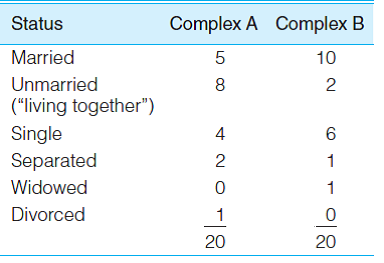
The Essentials of Statistics 3rd Edition by Joseph Healey
Edition 3ISBN: 978-1111831585
The Essentials of Statistics 3rd Edition by Joseph Healey
Edition 3ISBN: 978-1111831585 Exercise 1
Problems are labeled with the social science discipline from which they are drawn: SOC is for sociology, SW is for social work, PS is for Political Science, CJ is for Criminal Justice, PA is for Public Administration, and GER is for Gerontology.
SOC: The tables that follow report the marital status of 20 respondents in two different apartment complexes.

Read each of the following problems carefully before constructing the fraction and solving for the answer. (HINT: Make sure you have the correct numbers in the numerator and denominator before solving these problems. For example, problem 2.1a asks which "percentage of the respondents at each complex are married" and the denominators will be 20 for these two fractions. On the other hand, problem 2.1d, asks which "percentage of the single respondents live in Complex B" and the denominator for this fraction will be 4 + 6, or 10.)
a. What percentage of the respondents at each complex are married?
b. What is the ratio of single to married respondents at each complex?
c. What proportion of each sample are widowed?
d. What percentage of the single respondents live in Complex B?
e. What is the ratio of the unmarried/living together to the married at each complex?
SOC: The tables that follow report the marital status of 20 respondents in two different apartment complexes.

Read each of the following problems carefully before constructing the fraction and solving for the answer. (HINT: Make sure you have the correct numbers in the numerator and denominator before solving these problems. For example, problem 2.1a asks which "percentage of the respondents at each complex are married" and the denominators will be 20 for these two fractions. On the other hand, problem 2.1d, asks which "percentage of the single respondents live in Complex B" and the denominator for this fraction will be 4 + 6, or 10.)
a. What percentage of the respondents at each complex are married?
b. What is the ratio of single to married respondents at each complex?
c. What proportion of each sample are widowed?
d. What percentage of the single respondents live in Complex B?
e. What is the ratio of the unmarried/living together to the married at each complex?
Explanation
The given table follows that report the ...
The Essentials of Statistics 3rd Edition by Joseph Healey
Why don’t you like this exercise?
Other Minimum 8 character and maximum 255 character
Character 255



